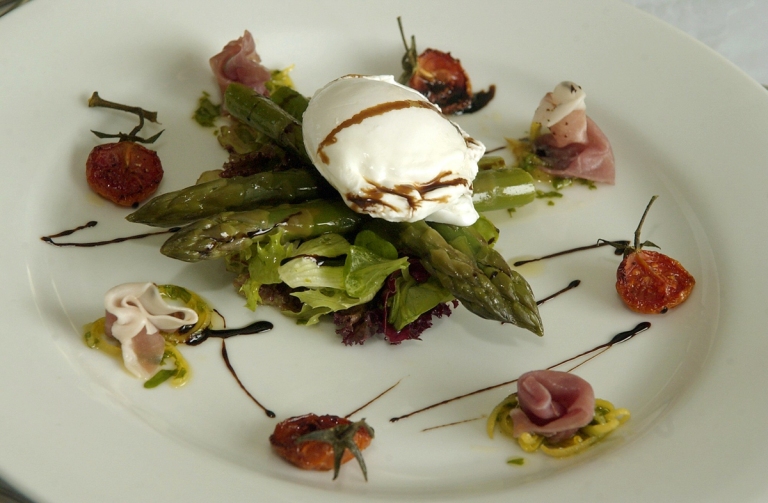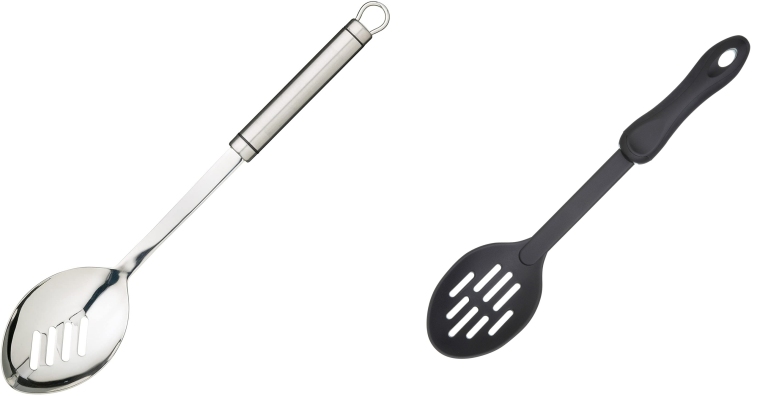
The area I live in is famous for quite a few ingredients, but between April 23rd and early June Asparagus takes centre stage. The secret in this simple looking dish is the timing and preparing things in the right order.
The Asparagus season in Worcestershire begins officially 23rd April which is St George’s Day and now runs into early June. Some consider Asparagus to be the king of vegetables, and other just roll their eyes when they hear such talk but if you make the effort to drive into the country you too will appreciate the huge difference between something grown locally and just pulled out of the ground that morning and Asparagus from the supermarket with 10,000 air miles on it. Of course this year because of Co-Vid 19, most of the Asparagus grown in the UK has been sold directly to supermarkets because if you are a farmer your farm gate business has disappeared. Hopefully, next year things will be back to normal.
Ingredients
4 large free-range eggs
16 Asparagus Spears
Juice and Zest from 1 large lemon
6 1/2 Tbsp extra virgin olive oil
½ Tbsp chopped coriander
50 ml Balsamic vinegar
100 grams Prosciutto ham
50 g sun-blushed tomatoes
1 Tbsp White wine vinegar
1 Small bag of mixed leaves
2 pinches of sea salt
Black pepper
Method
- Line up the tops of the Asparagus spears and trim off the bottom 5cm (2”), then peel the bottom of each spear to ensure any tough skin is removed.
- Pour the balsamic into a small nonstick saucepan; simmer on a medium low heat to reduce the vinegar until it is syrupy. Then pour the balsamic into a small cup and cling wrap to prevent further evaporation. As it cools check that the consistency is thick enough to lace across a plate making a zigzag pattern.
- Wash and drain the mixed leaves well, using a salad spinner if you own one to drain the salad leaves.
- Combine the Olive oil with the lemon zest and juice, coriander in a small container and shake well, then season with sea salt and black pepper and reserve.
- Using a pan large enough for the asparagus to lie flat in, fill with boiling water and a couple of pinches of sea salt.
- Cook the Asparagus for about 4-5 minutes then cool down completely in cold water, and then drain in a colander.
- Bring a medium-sized pan of water to the simmer, season with salt and pepper and add the white wine vinegar.
- Place a small handful of salad leaves in the center of four dinner plates.
- Poach the eggs 1 at a time for 3-4 minutes (so that the yolk is still soft) then remove and drain on a warm plate.
- Warm the Asparagus in a non-stick frying pan on a medium heat, using the remaining ½ tbsp olive oil.
- Lay 4 Asparagus spears on each plate, on top of the leaves.
- Then carefully top with a poached egg.
- Decorate with the prosciutto and sun-blushed tomatoes then drizzle with a little of the lemon dressing.
- Finally lace a zigzag of the reduced balsamic across each plate and serve.
Chef’s Tips
This dish is all about timing so why not try halving the recipe and make 2 portions to begin with.
Egg Poaching Tips
Make sure the water is simmering, not boiling, so the egg comes together neatly.
Crack each egg first into a saucer and then pour each egg one at a time from the saucer into the poaching water, rather than drop the egg from a great height. Use a large slotted kitchen spoon like these to gently “fish” them out. 
Local Asparagus with Poached Egg (serves 4) © Kevin Ashton 2006-2020
Please take a look at my other WordPress blogs
Very different. Looks pretty!
LikeLike
I agree.
Fresh asparagus is delicious.
LikeLiked by 2 people
And so versatile, but the season so fleeting and mourned when it is over.
LikeLiked by 1 person
The perfect late Spring meal. The touch of adding a little prosciutto and tomato sounds great.
LikeLike
Not the season here yet, but I love asparagus. Can’t wait for the warm weather to come round, Kevin. I’m even willing to give poached eggs a try.
LikeLiked by 2 people
Glad to hear it Mary. Your comment made me go back and read my post and realise I hadn’t given any tips on poaching eggs, which I have now added.
I really do like the interaction I have with my readers so a big thanks to you and
Best Wishes
Kevin
LikeLiked by 1 person
Thanks, Kevin. Your tips and step by step instructions are so good. The instant interaction / feedback is what I like best about blogging.
LikeLiked by 1 person
The plating is so beautiful. Like a garden of roses.
LikeLiked by 2 people
Thank you so much for your kind words.
LikeLiked by 1 person
Gorgeous presentation. I do like asparagus, but when I was in college, some of the students picked asparagus to make money (the local valley grew a lot of it). One week we had asparagus for breakfast, lunch and dinner in my dorm – there was a huge revolt!
LikeLiked by 2 people
Dear Noelle,
I do love the way food can trigger memories in all of us, is this story going to appear in one of your novels?
Best Wishes
Kevin
LikeLike
Not sure! I am currently working on the fifth in the Rhe Brewster series, which does contain quite a bit about food (I’ve been asked to create a Rhe Brewster cookbook) but too late for The Last Pilgrim, which came out this week. Did the Pilgrims even eat asparagus?
LikeLiked by 1 person
Dutch settler Adriaen van der Donck brought Asparagus from Europe in 1655 but I guess with a little artistic license someone could have taken a plant on the Mayflower. often food history is vague. For example, we know that the Egyptians, ancient Greeks and Romans all cultivated Asparagus. We also know that the word Asparagus was word in Middle English (which is dated roughly from 1150-1500 ). yet other scholars believe that Asparagus wasn’t cultivated in the UK until the seventeenth century.
LikeLiked by 1 person
This looks delicious! I love asparagus! I came across white asparagus for the forst time the other day and was wondering what it is like and what’s the difference?
LikeLiked by 1 person
White Asparagus is mainly grown in the Netherlands and Belgium. As the asparagus grows it is covered with a sandy soil, which prevents photosynthesis, keeping the spears milky white. As they grow, more soil is mounded up around them, keeping them covered until harvest. The flavour of white asparagus is milder than the green variety and slightly more bitter. Having lived and worked in Holland, I have tasted both and prefer the green, but I guess it depends on the type of asparagus you have grown up with.
LikeLike
I got cut off! Oh, well…Thanks for the history lesson. It’s possible aspargus made its way to the Plymouth Colony before the end of the 17th century!
LikeLiked by 1 person
Absolutely, and when new ingredients come to any country, the prices are high and the sometimes the rivalry to be the only one growing and selling it can be fierce. Remember asparagus is called the king of vegetables and was highly prized amongst royalty and the ruling classes.
LikeLike
Looks really delicious.
Broccoli has always been more of a go to vegetable than asparagus but your post has me wanting to include it more often in my meals.
Thank you.
LikeLiked by 2 people
You are most welcome.
LikeLiked by 1 person
Beautiful. I’ve made this dish twice this past month. Mine isn’t as pretty as yours.
Serve w prosciutto.
Yum.
Thanks for sharing
LikeLike
Looks good. Real art on a plate. I love Asparagus too much and I am sure I would enjoy the wonderful taste of your dish!!!!!!!!
LikeLike
Arata delicios…
Thanks!
LikeLiked by 1 person
amazing work
LikeLiked by 1 person
Thank you Nancy for your kind words and welcome to my blog.
Best Wishes
Kevin
LikeLike
I loved your beautiful presentation!
LikeLiked by 1 person
Thank you Deeksha, for your kind words.
Best Wishes
Kevin
LikeLiked by 1 person
I like asparagus and poach eggs, why not together? Thanks for the recipe.
LikeLiked by 1 person
Thank you Geri, for your kind words, glad you liked the recipe. 🙂
LikeLiked by 1 person
As a gesture of good friendship, can I make a request to have you as my chef on my wedding in 2023…
LikeLike